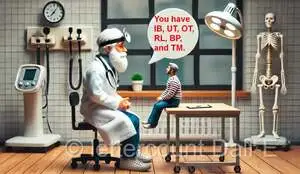Life progresses quickly, and sometimes, long-form language slows it down too much to be practical. Whether digital acronyms of “lol” and “btw,” abbreviations for “Dr.” and “Prof.” or even addresses shortened to “Ave.” and “Ct.”, we look everywhere for opportunities to get our points across faster. These short-hand solutions have a habit of finding their way into everyday conversation and communication, but they’re also increasingly important in business and branding. From the airline industry using short-hand for flight codes and phrases like “mayday”, to hashtags and search boxes directing us to pages of interest, and acronyms like PEMDAS in school to help us remember essential information—abbreviations and acronyms, often counted in letters or characters, are essential tools of communication. Learn more about where and why we use acronyms and abbreviations.
- Dot, period or full stop?
- Single or compound nouns and expressions truncations
- Telegraph, Internet and SMS short letter counts
Reducing the number of letters to only the initials of a single or compound name or commonly used expression is a practice almost as old as the language itself. Abbreviations have been found in texts more than 5000 years old.
Dot, period or full stop?
Given that the purpose of an abbreviation is to... abbreviate, one may ask: Are final periods required?
For example:
If Doctor is commonly shortened to two letters Dr., and Professor to four letters Prof., does it make sense at all to write the final period (full stop), given that the whole point is actually to end up with fewer characters?
In British English, there is a rule about that final full stop:
- if the abbreviation ends with the same letter as the full word (e.g., "Dr" for "Doctor"), then no full stop is needed
- if the abbreviation does not end with the same letter as the full word (e.g., "Prof." for "Professor"), then the full stop is needed.
American English prefers a period in both cases Dr. and Prof.; whereas International English finds either writing acceptable.

In all cases, consistency is essential. Your document should not use either method of abbreviation randomly. Using Dr. and Prof. or Dr and Prof throughout will always be understood, and neither should be regarded as mistaken. If charactercount is an issue to the point you have to use lettercount.com, it really does not make sense to write I.B.M. instead of IBM, or N.A.S.A. instead of NASA - period-less acronyms should be preferred and are perfectly acceptable.
Single or compound nouns and expressions truncations
Here are the most commonly used abbreviations:
1) in a general context:
Dr. (Doctor)
Mr. (Mister)
Mrs. (the origin of these three letters is Mistress, although it specifically refers to a married woman, and is pronounced Miss-eze)
Ms. (pronounced Miz; refers to a woman regardless of her marital status)
Miss (four letters, refers to an unmarried woman)
Prof. (Professor)
Gov. (Governor)
Rev. (Reverend)
Sr. (Senior)
Jr. (Junior)
Gen. (General)
Sgt. (Sergeant)
Definitely use these shortened versions in order to reduce the number of characters.

2) on maps and in addresses:
St. (Street)
Ave. (Avenue)
Blvd. or Bd. (Boulevard)
Rd. (Road)
Ln. (Lane)
Sq. (Square)
Ct. (Court or Crescent)
Dr. (Drive)
Pl. (Place)
3) days of the week:
Mon. (Monday)
Tue. (Tuesday)
Wed. (Wednesday)
Thu. (Thursday)
Fri. (Friday)
Sat. (Saturday)
Sun. (Sunday)
or even fewer characters: MO, TU, WE, TH, FR, SA, SU.

4) months:
Jan. - January
Feb. - February
Mar. - March
Apr. - April
May - May
Jun. - June
Jul. - July
Aug. - August
Sep. - September
Oct. - October
Nov. - November
Dec. - December
5) time-related:
Hr. or h - Hour
Min. or m - Minute
Sec. or s - Second
ms - Millisecond
AM - Ante Meridiem (before noon)
PM - Post Meridiem (after noon)
wk - Week
mo - Month
yr - Year
' - Minutes (prime symbol, often used in time notation)
" - Seconds (double prime symbol, often used in time notation)
Q1, Q2, Q3, Q4 - 1st, 2nd, 3rd, and 4th Quarters (of a year)
BC - Before Christ (used to denote years before the start of the Gregorian calendar)
AD - Anno Domini (used to denote years after the start of the Gregorian calendar)
BCE - Before Common Era (alternative to BC)
CE - Common Era (alternative to AD)
Many other abbreviations are in everyday use, like e.g. those on the Periodic Table of Elements (Au for gold; S for sulfur, etc.).
Telegraph, Internet and SMS short letter counts

Ever since modern wired and wireless communication appeared, there were strong incentives for a lower character count: the lower the number of letters, the lower the price; technical constraints and devices being increasingly used by non-professional typists who found all shortcuts welcome.
Already 170 years ago, the telegraph used these 1, 2 or 3-letter forms, which were universally understood:
NR - No Reply
OM - Old Man (used as a term of respect)
TNX - Thanks
K - Over (inviting a reply)
SK - End of contact
CQ - Calling any station (general call to all stations)
DX - Distance or long-distance communication
MSG - Message
73 - Best regards
FB - Fine Business (everything is good)
QRN - Static interference
QRM - Man-made interference
QSO - Conversation or contact
QTH - Location
QSL - Acknowledgment of receipt
QSB - Fading signal
QRT - Stop sending
Since the internet became our main communication medium, some 2, 3 or 4-letter forms appeared and are still in use:
LOL - Laughing Out Loud
AFK - Away From Keyboard
IMO - In My Opinion
IMHO - In My Humble Opinion
BTW - By The Way
FYI - For Your Information
IDK - I Don't Know
IRL - In Real Life
NVM - Never Mind
ROFL - Rolling On the Floor Laughing
SMH - Shaking My Head
TMI - Too Much Information
TBH - To Be Honest
TL;DR - Too Long; Didn't Read
OMG - Oh My God
ASAP - As Soon As Possible
GTG - Got To Go
JK - Just Kidding
BFF - Best Friends Forever
TTYL - Talk To You Later
Most of these are still widely used in SMS communications, which also popularized the use of ASCII emoticons:
Smiley :-)
Sad :-(
Wink ;-)
Grin :-D
Surprise :-O
Tongue Out :-P
Confused :-/
Crying :'-(
Kiss :-*
Skeptical :-|
Angry >:(
Cool B-)
Heart <3
... and many others.